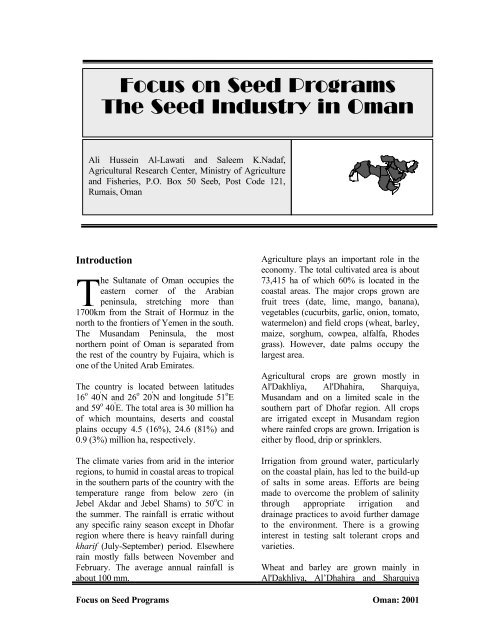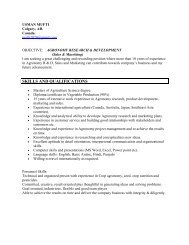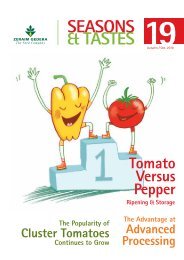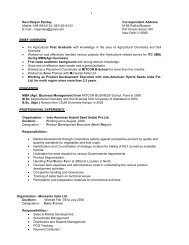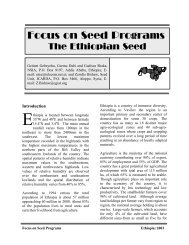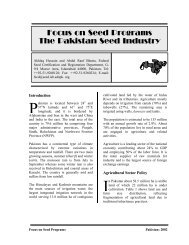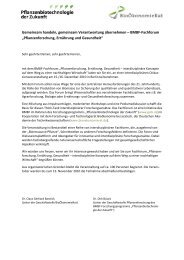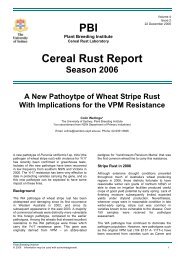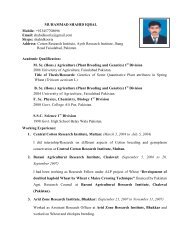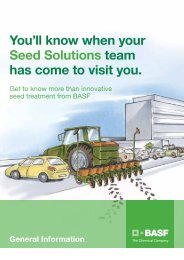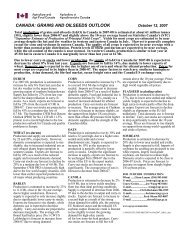Focus on Seed Programs The Seed Industry in Oman - SeedQuest
Focus on Seed Programs The Seed Industry in Oman - SeedQuest
Focus on Seed Programs The Seed Industry in Oman - SeedQuest
Create successful ePaper yourself
Turn your PDF publications into a flip-book with our unique Google optimized e-Paper software.
<str<strong>on</strong>g>Focus</str<strong>on</strong>g> <strong>on</strong> <strong>Seed</strong> <strong>Programs</strong><br />
<strong>The</strong> <strong>Seed</strong> <strong>Industry</strong> <strong>in</strong> <strong>Oman</strong><br />
Ali Husse<strong>in</strong> Al-Lawati and Saleem K.Nadaf,<br />
Agricultural Research Center, M<strong>in</strong>istry of Agriculture<br />
and Fisheries, P.O. Box 50 Seeb, Post Code 121,<br />
Rumais, <strong>Oman</strong><br />
Introducti<strong>on</strong><br />
<strong>The</strong> Sultanate of <strong>Oman</strong> occupies the<br />
eastern corner of the Arabian<br />
pen<strong>in</strong>sula, stretch<strong>in</strong>g more than<br />
1700km from the Strait of Hormuz <strong>in</strong> the<br />
north to the fr<strong>on</strong>tiers of Yemen <strong>in</strong> the south.<br />
<strong>The</strong> Musandam Pen<strong>in</strong>sula, the most<br />
northern po<strong>in</strong>t of <strong>Oman</strong> is separated from<br />
the rest of the country by Fujaira, which is<br />
<strong>on</strong>e of the United Arab Emirates.<br />
<strong>The</strong> country is located between latitudes<br />
16 o 40 ' N and 26 o 20 ' N and l<strong>on</strong>gitude 51 o E<br />
and 59 o 40 ' E. <strong>The</strong> total area is 30 milli<strong>on</strong> ha<br />
of which mounta<strong>in</strong>s, deserts and coastal<br />
pla<strong>in</strong>s occupy 4.5 (16%), 24.6 (81%) and<br />
0.9 (3%) milli<strong>on</strong> ha, respectively.<br />
<strong>The</strong> climate varies from arid <strong>in</strong> the <strong>in</strong>terior<br />
regi<strong>on</strong>s, to humid <strong>in</strong> coastal areas to tropical<br />
<strong>in</strong> the southern parts of the country with the<br />
temperature range from below zero (<strong>in</strong><br />
Jebel Akdar and Jebel Shams) to 50 o C <strong>in</strong><br />
the summer. <strong>The</strong> ra<strong>in</strong>fall is erratic without<br />
any specific ra<strong>in</strong>y seas<strong>on</strong> except <strong>in</strong> Dhofar<br />
regi<strong>on</strong> where there is heavy ra<strong>in</strong>fall dur<strong>in</strong>g<br />
kharif (July-September) period. Elsewhere<br />
ra<strong>in</strong> mostly falls between November and<br />
February. <strong>The</strong> average annual ra<strong>in</strong>fall is<br />
about 100 mm.<br />
Agriculture plays an important role <strong>in</strong> the<br />
ec<strong>on</strong>omy. <strong>The</strong> total cultivated area is about<br />
73,415 ha of which 60% is located <strong>in</strong> the<br />
coastal areas. <strong>The</strong> major crops grown are<br />
fruit trees (date, lime, mango, banana),<br />
vegetables (cucurbits, garlic, <strong>on</strong>i<strong>on</strong>, tomato,<br />
watermel<strong>on</strong>) and field crops (wheat, barley,<br />
maize, sorghum, cowpea, alfalfa, Rhodes<br />
grass). However, date palms occupy the<br />
largest area.<br />
Agricultural crops are grown mostly <strong>in</strong><br />
Al'Dakhliya, Al'Dhahira, Sharquiya,<br />
Musandam and <strong>on</strong> a limited scale <strong>in</strong> the<br />
southern part of Dhofar regi<strong>on</strong>. All crops<br />
are irrigated except <strong>in</strong> Musandam regi<strong>on</strong><br />
where ra<strong>in</strong>fed crops are grown. Irrigati<strong>on</strong> is<br />
either by flood, drip or spr<strong>in</strong>klers.<br />
Irrigati<strong>on</strong> from ground water, particularly<br />
<strong>on</strong> the coastal pla<strong>in</strong>, has led to the build-up<br />
of salts <strong>in</strong> some areas. Efforts are be<strong>in</strong>g<br />
made to overcome the problem of sal<strong>in</strong>ity<br />
through appropriate irrigati<strong>on</strong> and<br />
dra<strong>in</strong>age practices to avoid further damage<br />
to the envir<strong>on</strong>ment. <strong>The</strong>re is a grow<strong>in</strong>g<br />
<strong>in</strong>terest <strong>in</strong> test<strong>in</strong>g salt tolerant crops and<br />
varieties.<br />
Wheat and barley are grown ma<strong>in</strong>ly <strong>in</strong><br />
Al'Dakhliya, Al’Dhahira and Sharquiya<br />
<str<strong>on</strong>g>Focus</str<strong>on</strong>g> <strong>on</strong> <strong>Seed</strong> <strong>Programs</strong> <strong>Oman</strong>: 2001
2<br />
regi<strong>on</strong>s under irrigated c<strong>on</strong>diti<strong>on</strong> and <strong>on</strong> a<br />
small scale <strong>in</strong> Musandam area under ra<strong>in</strong>fed<br />
c<strong>on</strong>diti<strong>on</strong>. Moreover, barley is also grown<br />
for fodder as pure stands or as mixture with<br />
alfalfa throughout the country.<br />
In the Bat<strong>in</strong>ah regi<strong>on</strong>, farmers grow mostly<br />
fruit trees, vegetables and fodder crops such<br />
as alfalfa and Rhodes grass. In Dhofar<br />
regi<strong>on</strong>, apart from fruit trees, vegetables<br />
and fodder crops are also grown al<strong>on</strong>g the<br />
coast. <strong>The</strong> major field crops grown <strong>in</strong><br />
Sultanate of <strong>Oman</strong> are <strong>in</strong>dicated <strong>in</strong> Table 1.<br />
Table 1. List of major crops grown <strong>in</strong><br />
Sultanate of <strong>Oman</strong><br />
___________________________________<br />
Cereals<br />
Legumes<br />
Oilseeds<br />
Fodder grasses<br />
Fodder legumes<br />
Fiber crops<br />
Sugar crops<br />
Wheat, Barley, Sorghum<br />
Chickpea, Mung bean,<br />
Lentil, Faba bean,<br />
Pige<strong>on</strong> pea<br />
Groundnut, Sesame,<br />
Safflower, Sunflower<br />
Maize, Sorghum, Pearl<br />
millet, Rhodes grass,<br />
Elephant grass<br />
Lucerne, Lablab,<br />
Cowpea<br />
Cott<strong>on</strong><br />
Sugarcane<br />
Stimulants Tobacco<br />
___________________________________<br />
New crops such as mung bean, sunflower,<br />
buffel grass, green panic, signal grass,<br />
Sudan grass and Siratro have been<br />
<strong>in</strong>troduced to test their adaptati<strong>on</strong> to <strong>Oman</strong>i<br />
c<strong>on</strong>diti<strong>on</strong>s.<br />
<strong>The</strong> estimated area and producti<strong>on</strong> of<br />
different crops (gra<strong>in</strong> and fodder) dur<strong>in</strong>g<br />
1999 is given <strong>in</strong> Table 2.<br />
Table 2. Area and crop producti<strong>on</strong> <strong>in</strong><br />
Sultanate of <strong>Oman</strong><br />
___________________________________<br />
Crops Area Producti<strong>on</strong><br />
(ha) ('000 t<strong>on</strong>nes)<br />
___________________________________<br />
Wheat 325 1.00<br />
Barley 1,285 3.79<br />
Sorghum 3201 14.7<br />
Sugarcane 109 1.00<br />
Others 1,692 4.90<br />
Alfalfa 11,321 472.15<br />
Rhodes grass 6492 275.29<br />
Elephant grass 2949 13.72<br />
___________________________________<br />
Nati<strong>on</strong>al <strong>Seed</strong> Policy and Laws<br />
<strong>The</strong> Nati<strong>on</strong>al <strong>Seed</strong> Policy and<br />
regulatory framework is be<strong>in</strong>g<br />
under development as a<br />
c<strong>on</strong>stituent/chapter of Agricultural law<br />
pert<strong>in</strong>ent to regulati<strong>on</strong>s for varieties,<br />
quality c<strong>on</strong>trol, certificati<strong>on</strong> and seed<br />
trade, which will be enacted by the Royal<br />
Decree. This Royal Decree <strong>on</strong> Agriculture<br />
will replace all the previous laws<br />
c<strong>on</strong>cern<strong>in</strong>g similar aspects <strong>on</strong> agriculture.<br />
In October 2000, the Royal Decree No.<br />
92/2000 issued the plant variety protecti<strong>on</strong><br />
law. <strong>The</strong> decree c<strong>on</strong>ta<strong>in</strong>s two chapters and<br />
24 articles. <strong>The</strong> implement<strong>in</strong>g regulati<strong>on</strong><br />
of the law will cover the follow<strong>in</strong>g<br />
aspects: general provisi<strong>on</strong>s, c<strong>on</strong>diti<strong>on</strong>s of<br />
the breeder’s rights, scope of protecti<strong>on</strong>,<br />
transfer and loss of rights, jo<strong>in</strong>t ownership<br />
of certificates, fil<strong>in</strong>g of applicati<strong>on</strong>s for<br />
plant variety certificates, prosecuti<strong>on</strong> of<br />
applicati<strong>on</strong>s for plant variety certificates,<br />
issue of plant variety certificates and legal<br />
proceed<strong>in</strong>gs. <strong>The</strong> PVP executive<br />
regulati<strong>on</strong>s have been already f<strong>in</strong>alized<br />
which will be published <strong>in</strong> the near future.<br />
<str<strong>on</strong>g>Focus</str<strong>on</strong>g> <strong>on</strong> <strong>Seed</strong> <strong>Programs</strong> <strong>Oman</strong>: 2001
3<br />
<strong>The</strong> M<strong>in</strong>istry of Agriculture and Fisheries<br />
(MAF) would be resp<strong>on</strong>sible to enforce<br />
PVP law.<br />
Agricultural Research<br />
In the 1970s and 1980s agricultural<br />
research <strong>on</strong> wheat, barley and other<br />
field crops was carried out at Wadi<br />
Quriyat agricultural research stati<strong>on</strong> <strong>in</strong> the<br />
<strong>in</strong>terior regi<strong>on</strong> of the country. At present<br />
major research <strong>on</strong> field crops are c<strong>on</strong>ducted<br />
<strong>in</strong> six stati<strong>on</strong>s based at Al-Kamil, Jimah,<br />
Nejid, Rumais, Salalah and Sohar. <strong>The</strong><br />
research stati<strong>on</strong>s at Al-Kamil, Jimah and<br />
Salalah deal with gra<strong>in</strong>, fodder and fruit<br />
crops whereas the stati<strong>on</strong>s at Nejid, Rumais<br />
and Sohar deal with fodder and fruit crops.<br />
<strong>The</strong> agricultural research <strong>in</strong>cludes variety<br />
development, evaluati<strong>on</strong> and agr<strong>on</strong>omic<br />
management. <strong>The</strong> plant protecti<strong>on</strong> units<br />
c<strong>on</strong>duct research <strong>on</strong> diseases and pests.<br />
Several results have been obta<strong>in</strong>ed <strong>in</strong><br />
different aspects of crop producti<strong>on</strong>. S<strong>in</strong>ce<br />
1999, the Director General of Agriculture<br />
and Assistant Director General for<br />
Agricultural Research and Extensi<strong>on</strong> are<br />
resp<strong>on</strong>sible for the activities of agriculture<br />
research.<br />
Genetic Resources C<strong>on</strong>servati<strong>on</strong><br />
<strong>The</strong> germplasm of local landraces has been<br />
collected <strong>in</strong> collaborati<strong>on</strong> with IPGRI and<br />
ICARDA and stored <strong>in</strong> <strong>Oman</strong> and stored at<br />
ICARDA gene bank. Moreover, wild<br />
relatives of wheat and barley were also<br />
collected from the mounta<strong>in</strong> regi<strong>on</strong>s to<br />
study the orig<strong>in</strong> and distributi<strong>on</strong> of these<br />
crops <strong>in</strong> the Arabian Pen<strong>in</strong>sula.<br />
Variety Development<br />
For wheat, barley and chickpea<br />
<strong>in</strong>ternati<strong>on</strong>al nurseries or regi<strong>on</strong>al trials are<br />
received from ICARDA and ACSAD<br />
whereas for other crops such as vegetables,<br />
annual and perennial forage grasses and<br />
legumes, fodder beet, Atriplex spp, etc. are<br />
received from seed companies <strong>in</strong> Australia,<br />
Holland, India, USA, etc. At present wheat,<br />
barley and chickpea crosses for disease<br />
resistance are obta<strong>in</strong>ed from <strong>in</strong>ternati<strong>on</strong>al<br />
nurseries supplied by ICARDA and from<br />
organizati<strong>on</strong>s such as ICRISAT for crops<br />
such as groundnut, forage sorghum and<br />
pearl millet etc. <strong>The</strong> <strong>in</strong>troduced l<strong>in</strong>es are<br />
tested for three years at research stati<strong>on</strong>s<br />
and selected for high yields and other<br />
desirable agr<strong>on</strong>omic characters. <strong>The</strong><br />
selected l<strong>in</strong>es are further tested for <strong>on</strong>e year<br />
<strong>in</strong> larger plots <strong>on</strong> farmers' fields, which<br />
forms the basis for f<strong>in</strong>al selecti<strong>on</strong> and<br />
release of the variety.<br />
<strong>The</strong> high yield<strong>in</strong>g elite genotypes are<br />
recommended for release based <strong>on</strong> the<br />
recommendati<strong>on</strong> of field crop scientists<br />
who are <strong>in</strong>volved <strong>in</strong> carry<strong>in</strong>g out variety<br />
performance trails <strong>in</strong> different locati<strong>on</strong>s and<br />
years at research stati<strong>on</strong>s and farmers’<br />
fields. <strong>The</strong> list of recommended crop<br />
varieties is given <strong>in</strong> Table 3. In the future<br />
the M<strong>in</strong>istry of Agriculture and Fisheries<br />
(MAF) would be resp<strong>on</strong>sible to enforce<br />
PVP law and carry<strong>in</strong>g out DUS tests.<br />
However, quite a large crop area is under<br />
local landraces. <strong>The</strong> wheat landraces are<br />
Cooley (covers 80% of local area), Sarraya,<br />
Missa<strong>in</strong>, Hamira and Walidi. <strong>The</strong> barley<br />
landraces are named after the area <strong>in</strong> which<br />
they are grown and known as Al'Dakhliya,<br />
Sharquiya, Bath<strong>in</strong>i and Duraqui<br />
(Musandam area). Many local landraces are<br />
also available for crops such as chickpea<br />
(<strong>Oman</strong>i), cowpea (<strong>Oman</strong>i, Dhofari),<br />
sorghum (<strong>Oman</strong>i, Rustaqui) and alfalfa<br />
(<strong>Oman</strong>i, Bath<strong>in</strong>i, Dhofari, Sharqui,<br />
Quiyahi).<br />
<str<strong>on</strong>g>Focus</str<strong>on</strong>g> <strong>on</strong> <strong>Seed</strong> <strong>Programs</strong> <strong>Oman</strong>: 2001
4<br />
Table 3. List of recommended crop varieties<br />
____________________________________________________________________________<br />
Crops<br />
Varieties<br />
____________________________________________________________________________<br />
Wheat<br />
Mexipak, Sann<strong>in</strong>e, WQS151, WQS160, WQS302, WQS305, WQS308,<br />
Jimah1, Jimah2, Jimah 101, Jimah 102, Jimah 103, Jimah 107, Jimah<br />
110, Jimah 125, Jimah 132<br />
Barley Beecher, Jimahh5, Jimah6, Jimah 51, Jimah 53, Jimah 54, Jimah 58,<br />
Jimah 98, Jimah 136<br />
Cowpea Jimah 2, Jimah3, Jimah 4<br />
Chickpea ILC237, Jimah7, Jimah8, Jimah 1, Jimah 2, Jimah 17, Jimah 18<br />
Dry peas<br />
ARC-2 (Rumais2), ARC-3 (Rumais3), ARC-4 (Rumais4), ARC-5<br />
(Rumais5), (ARC-6 (Rumais6), ARC-7 (Rumais7)<br />
Mungbean PS-16, S<strong>on</strong>a, PDM 84-13<br />
Sesame Giza 23<br />
Safflower A-300, A-1<br />
Sunflower<br />
Maize<br />
Turkey-79, Miak<br />
Giza2, Katamani503, Hybrid 622, Irat8, Sohar1, Sohar2, Rumais<br />
Composite 1, Rumais Composite 2, Rumais Composite 3<br />
Sorghum Sugar drip, H<strong>on</strong>ey drop, Fs x Dekalb 17<br />
Fodder Oats<br />
Rhodes grass<br />
Alfalfa<br />
Marloo, ARC-1 (Rumais1)<br />
Callide, Katamboa, Samford, Elamba, Boma, Pi<strong>on</strong>eer<br />
ADLL 6725, CUF 101, Cundor, DK 187, Maxidor, Sequel<br />
Fodder beet Peram<strong>on</strong>o,Petra,Anissa<br />
____________________________________________________________________________<br />
Wheat and barley are major field crops<br />
where a substantial number of improved<br />
<str<strong>on</strong>g>Focus</str<strong>on</strong>g> <strong>on</strong> <strong>Seed</strong> <strong>Programs</strong> <strong>Oman</strong>: 2001
5<br />
varieties have been released. <strong>The</strong> details of<br />
wheat and barley varieties grown are given<br />
<strong>in</strong> Table 4.<br />
Table 4. Characteristics of released wheat and barley varieties<br />
____________________________________________________________________________<br />
Varieties Source Year Yield<br />
Released<br />
(t/ha)<br />
____________________________________________________________________________<br />
Wheat<br />
Mexipak Pakistan 1972 2.1<br />
Sann<strong>in</strong>e Leban<strong>on</strong> 1974 3.2<br />
WQS160 ICARDA 1985/86 3.2<br />
WQS151 ICARDA 1985/86 2.9<br />
WQS308 CIMMYT/ICARDA 1992/93 3.1<br />
WQS305 CIMMYT/ICARDA 1993/94 3.5<br />
Jimah1 1 CIMMYTT/ICARDA 1996/97 3.0<br />
Jimah2 1 CIMMYT/ICARDA 1996/97 3.9<br />
Jimah 101 CIMMYT/ICARDA 1997/98 3.25<br />
Jimah 102 CIMMYT/ICARDA 1997/98 3.3<br />
Jimah 103 CIMMYT/ICARDA 1997/98 3.1<br />
Jimah 107 CIMMYT/ICARDA 1998/99 4.9<br />
Jimah 110 CIMMYT/ICARDA 1998/99 4.9<br />
Jimah 125 CIMMYT/ICARDA 1999/00 4.9<br />
Jimah 132 CIMMYT/ICARDA 1999/00 4.0<br />
Barley<br />
Beecher ICARDA 1974 3.9 2<br />
Jimah 6 1 ICARDA 1992-93 3.8<br />
Jimah 51 ICARDA 1993-94 4.1<br />
Jimah 53 ICARDA 1993-94 3.3<br />
Jimah 54 ICARDA 1993-94 4.0<br />
Jimah 58 ICARDA 1993-94 3.3<br />
Jimah 98 ICARDA 1999-2000 4.6<br />
Jimah 136 ICARDA 1999-2000 4.5<br />
____________________________________________________________________________<br />
1 Recommended but still not grown by farmers; 2 Green fodder yield is 25.3 t/ha<br />
Agr<strong>on</strong>omic Research<br />
In <strong>Oman</strong> there are two cropp<strong>in</strong>g seas<strong>on</strong>s:<br />
w<strong>in</strong>ter and summer. W<strong>in</strong>ter crops are<br />
planted <strong>in</strong> October or November and<br />
<strong>in</strong>clude wheat, barley, maize, rye, oats, pea,<br />
chickpea, alfalfa and Rhodes grass. <strong>The</strong><br />
summer crops are planted <strong>in</strong> March-April<br />
and <strong>in</strong>clude sorghum, millets, cowpea,<br />
<str<strong>on</strong>g>Focus</str<strong>on</strong>g> <strong>on</strong> <strong>Seed</strong> <strong>Programs</strong> <strong>Oman</strong>: 2001
6<br />
sesame, maize (fodder), alfalfa and Rhodes<br />
grass.<br />
Agr<strong>on</strong>omic practices were identified and<br />
recommended for all major crops. <strong>The</strong> seed<br />
and fertilizer rate and expected gra<strong>in</strong> yield<br />
are given <strong>in</strong> Table 5. Although all crops are<br />
grown under irrigated c<strong>on</strong>diti<strong>on</strong>s the yield<br />
level is low due to unfavorable climatic<br />
c<strong>on</strong>diti<strong>on</strong>s.<br />
Table 5. Agr<strong>on</strong>omic practices recommended for field crops<br />
Crop <strong>Seed</strong> rate Fertilzer 1 Yield<br />
kg/ha (N-P-K) kg ha -1<br />
Wheat 100-25 150-90-60 2500-3000<br />
Barley 100-25 100-90-60 2500-4000<br />
Maize 35-50 2 200-100-50 2500-4000<br />
Sorghum 30-40 2 150-100-50 2500-3000<br />
Cowpea 100-25 100-100-50 1000-2500<br />
Chickpea 3 75-100 100-100-50 1500-2000<br />
Dry pea 3 80-120 100-100-50 1500-2000<br />
Sesame 6-10 100-100-50 700-1500<br />
Alfalfa 25-30 200-120-250 150-175 4<br />
Rhodes grass 10-12 1200-150-150 100-125 4<br />
Oats (fodder) 100-125 100-90-60 1000-1500<br />
Note: 1 P and K are applied at sow<strong>in</strong>g time whereas N is applied at plant<strong>in</strong>g and as split [4 splits (wheat, barley,<br />
oats); 3 splits (sorghum, maize); 2 splits (chickpea, cowpea, dry pea, sesame); 1/10 after each cut (alfalfa, Rhodes)];<br />
2 For fodder seed rate is 75-90kgha -1 for maize and 50-70kgha -1 for sorghum; 3 Chickpea and dry pea are not<br />
<strong>in</strong>oculated and no bacterial nodules present <strong>in</strong> the soil, so higher doses of N are used; 4 Green fodder yield <strong>in</strong> t<strong>on</strong>nes.<br />
<strong>Seed</strong> Producti<strong>on</strong> and Supply<br />
In Sultanate of <strong>Oman</strong> the nati<strong>on</strong>al seed<br />
program is still at an early stage of<br />
development. <strong>Seed</strong> producti<strong>on</strong> was<br />
started <strong>in</strong> 1979 under the direct supervisi<strong>on</strong><br />
of agricultural research stati<strong>on</strong>s and<br />
restricted to Al'Dakhliya area. However, the<br />
program was later expanded to cover<br />
Al'Sharqiya and Al'Dharhira and become<br />
under the direct supervisi<strong>on</strong> of the<br />
extensi<strong>on</strong> service.<br />
<strong>The</strong> Government undertakes the<br />
resp<strong>on</strong>sibility of seed producti<strong>on</strong>,<br />
particularly of some important crops such<br />
as wheat and barley. Breeder (by ear to row<br />
method) and foundati<strong>on</strong> seed of<br />
recommended varieties are ma<strong>in</strong>ta<strong>in</strong>ed and<br />
multiplied at regi<strong>on</strong>al agricultural research<br />
centers, under the supervisi<strong>on</strong> of crop<br />
scientists.<br />
<strong>The</strong> foundati<strong>on</strong> seed is supplied to the<br />
<str<strong>on</strong>g>Focus</str<strong>on</strong>g> <strong>on</strong> <strong>Seed</strong> <strong>Programs</strong> <strong>Oman</strong>: 2001
7<br />
agricultural extensi<strong>on</strong> service, which<br />
produce certified seed of wheat and barley<br />
<strong>on</strong> c<strong>on</strong>tractual agreement with farmers. <strong>The</strong><br />
seed of other crops is multiplied <strong>on</strong> limited<br />
scale at agricultural research stati<strong>on</strong>s. <strong>The</strong><br />
seed is produced under the direct<br />
supervisi<strong>on</strong> of the extensi<strong>on</strong> service, but a<br />
research-extensi<strong>on</strong> committee oversees the<br />
program. <strong>The</strong> area planted for seed<br />
producti<strong>on</strong> dur<strong>in</strong>g the last three years is<br />
presented <strong>in</strong> Table 6.<br />
<strong>The</strong> extensi<strong>on</strong> service is resp<strong>on</strong>sible for<br />
selecti<strong>on</strong> of c<strong>on</strong>tract farmers; provisi<strong>on</strong> of<br />
seed, fertilizers, plant protecti<strong>on</strong> services;<br />
technical backstopp<strong>in</strong>g and supervisi<strong>on</strong>;<br />
and f<strong>in</strong>ancial support for rogu<strong>in</strong>g seed<br />
crops. It also provides gunny bags and<br />
purchase seed at premium price, treat and<br />
store until distributi<strong>on</strong>. <strong>The</strong> farmer provides<br />
the land and irrigati<strong>on</strong> and is resp<strong>on</strong>sible for<br />
general cultivati<strong>on</strong> and harvest<strong>in</strong>g of seed<br />
crops.<br />
Table 6. Area and producti<strong>on</strong> of certified seed <strong>in</strong> <strong>Oman</strong><br />
Regi<strong>on</strong> Crops Area (feddans)/ 1998/9 1999/0 2000/1 2001/2<br />
Producti<strong>on</strong> (t<strong>on</strong>nes)<br />
Al-Dakhliya Wheat Area (f) 61 61 62 58<br />
Producti<strong>on</strong> (t) 61 61 74.4 75.4<br />
Barley Area (f) 7 7 13 14<br />
Producti<strong>on</strong> (t) 5.6 5.6 20.8 22.4<br />
Al- Dhahira Wheat Area (f) 38 38 41 45<br />
Producti<strong>on</strong> (t) 38 38 49.2 58.5<br />
Barley Area (f 7 7 9 13<br />
Producti<strong>on</strong> (t) 5.6 5.6 14.4 20.8<br />
Al-Sharqiya Wheat Area (f) 34 33 32 9<br />
Producti<strong>on</strong> (t) 34 33 38.4 11.7<br />
Barley Area (f) 3 3 7.5 6<br />
Producti<strong>on</strong> (t) 4.8 4.8 12 9.6<br />
Bat<strong>in</strong>ah Wheat Area (f) 33 22 23 28<br />
Producti<strong>on</strong> (t) 33 22 27.6 36.4<br />
Barley Area (f) - - - 3<br />
Producti<strong>on</strong> (t) - - - 4.8<br />
Muscat Wheat Area (f) 2 2 - -<br />
Producti<strong>on</strong> (t) 2 2 - -<br />
<str<strong>on</strong>g>Focus</str<strong>on</strong>g> <strong>on</strong> <strong>Seed</strong> <strong>Programs</strong> <strong>Oman</strong>: 2001
Musandam<br />
Barley<br />
Wheat<br />
Barley<br />
8<br />
Area (f) - - - 1.5<br />
Producti<strong>on</strong> (t) - - - 2.4<br />
Area (f) 2 25 25 20<br />
Producti<strong>on</strong> (t) 2 25 25 20<br />
Area (f) - - - 2.5<br />
Producti<strong>on</strong> (t) - - - 4<br />
Most farmers produce their own alfalfa<br />
seed. Generally seed is harvested from<br />
alfalfa crop of 4-5 years. This practice of<br />
harvest<strong>in</strong>g seed from old stands applies a<br />
str<strong>on</strong>g selecti<strong>on</strong> pressure <strong>in</strong> favor of those<br />
plants which have survived several years<br />
of cutt<strong>in</strong>g. It will tend to ensure that these<br />
important 'survival' characteristics are<br />
preserved and enhanced <strong>in</strong> successive<br />
multiplicati<strong>on</strong>. This may expla<strong>in</strong> <strong>in</strong> part<br />
the widespread reputati<strong>on</strong> of the alfalfa<br />
variety known as '<strong>Oman</strong>i' <strong>in</strong> the regi<strong>on</strong>.<br />
For vegetables, there is no local seed<br />
producti<strong>on</strong> program either by the<br />
Government or private sector. Several<br />
<strong>in</strong>ternati<strong>on</strong>al seed companies have branches<br />
<strong>in</strong> the country <strong>in</strong> associati<strong>on</strong> with local seed<br />
companies or agents. <strong>The</strong>se companies<br />
import seed of promis<strong>in</strong>g varieties from<br />
USA, Australia, Arab, Asian, African and<br />
European countries and supply the seed<br />
directly to the farmers or through the<br />
Government. However, some farmers<br />
produce the seeds of local cultivars of<br />
vegetables like <strong>on</strong>i<strong>on</strong>, garlic, carrot,<br />
cucumber, musk mel<strong>on</strong> and sweet potato.<br />
and Nizwa of the M<strong>in</strong>istry of Agriculture<br />
and Fisheries under the supervisi<strong>on</strong> of<br />
Director Generals of the regi<strong>on</strong>s. <strong>The</strong> seed<br />
is distributed free of cost to farmers for<br />
general cultivati<strong>on</strong>.<br />
<strong>Seed</strong> Market<strong>in</strong>g and Distributi<strong>on</strong><br />
Wheat and barley seed is<br />
distributed to <strong>in</strong>terested farmers<br />
free of cost while <strong>in</strong> other crops<br />
like vegetables, perennial forages, etc.<br />
farmers purchase the seed from various<br />
companies that import seed for sale.<br />
Besides some farmers sell their own seed of<br />
<strong>Seed</strong> Process<strong>in</strong>g and Storage<br />
<strong>Seed</strong> process<strong>in</strong>g is carried out by the<br />
agricultural extensi<strong>on</strong> services <strong>in</strong><br />
different locati<strong>on</strong>s with the limited<br />
facilities available. After clean<strong>in</strong>g seed is<br />
bagged <strong>in</strong> new bags provided by the<br />
extensi<strong>on</strong> service where the variety name<br />
and the quantity are <strong>in</strong>dicated. <strong>The</strong> seed is<br />
fumigated and stored <strong>in</strong> temporary storage<br />
at the regi<strong>on</strong>al offices at Dhahira, Ibra, Ibri<br />
<str<strong>on</strong>g>Focus</str<strong>on</strong>g> <strong>on</strong> <strong>Seed</strong> <strong>Programs</strong> <strong>Oman</strong>: 2001
10<br />
C<strong>on</strong>stra<strong>in</strong>ts <strong>in</strong> the <strong>Seed</strong> Sector<br />
<strong>The</strong> M<strong>in</strong>istry of Agriculture and<br />
Fisheries are strengthen<strong>in</strong>g the<br />
nati<strong>on</strong>al seed sector to overcome<br />
some major c<strong>on</strong>stra<strong>in</strong>ts such as shortage of<br />
tra<strong>in</strong>ed local pers<strong>on</strong>nel and seed policy.<br />
<strong>The</strong> Government undertakes seed<br />
producti<strong>on</strong> of important field crops such as<br />
wheat and barley <strong>on</strong> a limited scale. <strong>The</strong><br />
farmers produce their own seed for crops<br />
such as chickpea, cow pea alfalfa,<br />
sorghum, etc. For example, farmers produce<br />
seed of local varieties of alfalfa from old<br />
stands (>5 years) just by skipp<strong>in</strong>g cutt<strong>in</strong>g <strong>in</strong><br />
early/late w<strong>in</strong>ter and harvest<strong>in</strong>g seed when<br />
the crop is mature.<br />
S<strong>in</strong>ce there is no local seed producti<strong>on</strong> for<br />
vegetable crops and the country is entirely<br />
dependent <strong>on</strong> import. <strong>The</strong> private seed<br />
agencies sell imported seed at fairly high<br />
prices. Furthermore, there are no local<br />
companies com<strong>in</strong>g forward to <strong>in</strong>vest <strong>in</strong> seed<br />
producti<strong>on</strong> of <strong>in</strong>digenous popular cultivars<br />
of different crops such as alfalfa, vegetables<br />
(garlic, <strong>on</strong>i<strong>on</strong>, carrot, cucumber, musk<br />
mel<strong>on</strong>, sweet potato etc.) to expand the area<br />
<strong>in</strong> these crops.<br />
Recommendati<strong>on</strong>s for the <strong>Seed</strong><br />
Sector<br />
<strong>The</strong> development of seed <strong>in</strong>dustry<br />
should be a priority for the progress<br />
of agriculture <strong>in</strong> the country. At<br />
present there is limited supply of seed of<br />
agricultural crops and vegetables,<br />
respectively by the extensi<strong>on</strong> service and<br />
the private seed companies. <strong>The</strong>re is str<strong>on</strong>g<br />
need to develop local capacity for<br />
producti<strong>on</strong> and supply of quality seed <strong>in</strong> the<br />
country for all the major crops grown by the<br />
farmers. In the years to come, seed supply<br />
could assume greater importance and the<br />
seed demand expected to c<strong>on</strong>t<strong>in</strong>ue<br />
<strong>in</strong>creas<strong>in</strong>g for commercial crop producti<strong>on</strong>.<br />
A c<strong>on</strong>certed effort to strengthen nati<strong>on</strong>al<br />
seed program would help to (a) <strong>in</strong>crease<br />
agricultural producti<strong>on</strong> through adopti<strong>on</strong> of<br />
improved varieties and use of quality seed,<br />
(b) enhance systematic and rapid<br />
multiplicati<strong>on</strong> of seed of new varieties, (c)<br />
facilitate timely supply of seed to the<br />
farmers, and (d) facilitate seed supply at a<br />
reas<strong>on</strong>able price.<br />
<strong>The</strong> human resource development,<br />
upgrad<strong>in</strong>g the skill and knowledge of both<br />
professi<strong>on</strong>al and technical staff through <strong>in</strong>service<br />
tra<strong>in</strong><strong>in</strong>g or post-graduate studies <strong>in</strong><br />
seed technology <strong>in</strong> collaborati<strong>on</strong> with the<br />
Internati<strong>on</strong>al Center for Agricultural<br />
Research <strong>in</strong> the Dry Areas (WANA <strong>Seed</strong><br />
Network) or through other <strong>in</strong>ternati<strong>on</strong>al<br />
organizati<strong>on</strong>s is very essential. <strong>The</strong>se<br />
would help to develop the agriculture of<br />
the country and to achieve self-sufficiency<br />
<strong>in</strong> food crops such as wheat by exploit<strong>in</strong>g<br />
the potential of modern agriculture.<br />
‘<str<strong>on</strong>g>Focus</str<strong>on</strong>g> <strong>on</strong> <strong>Seed</strong> <strong>Programs</strong>’ is a series of country reports published<br />
by the WANA <strong>Seed</strong> Network Secretariat, <strong>Seed</strong> Unit, ICARDA, P.O.<br />
Box 5466, Aleppo, Syria; Tel: ++963-2213433; Fax: ++963-21-<br />
2213490; E-mail: Z.Bishaw@cgiar.org<br />
<str<strong>on</strong>g>Focus</str<strong>on</strong>g> <strong>on</strong> <strong>Seed</strong> <strong>Programs</strong> <strong>Oman</strong>: 2001


